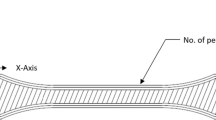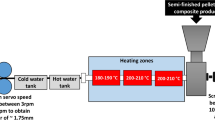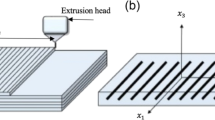Abstract
Liquid composite moulding (LCM) processes show a high potential in automated, large scale production of continuous fibre-reinforced plastics (FRP). One of the most challenging steps is the forming of the two-dimensional textile material into a complex, three-dimensional fibre structure. In this paper, a multi-punch forming process is presented. The upper mould of a generic part geometry is divided into 15 independently controllable punches. Depending on the different punch sequences, draping effects as well as defects related to wrinkling and shearing of the textile material are investigated. It has been shown that the sequence of the punches has a significant influence on the final preform quality. To predict the resulting regions of wrinkling and shearing, a finite-element based simulation model is set up. Forming tests and simulations with different punch-sequences are then performed and evaluated for validation purposes. To make a statement about the global preform quality, different objective functions regarding wrinkling are presented and analysed.














Similar content being viewed by others
References
Goede M, Stehlin M, Rafflenbeul L et al (2009) Super light car—lightweight construction thanks to a multi-material design and function integration. Eur Transp Res Rev 1(1):5–10. https://doi.org/10.1007/s12544-008-0001-2
Marsh G (2004) Can composites get firmly on the rails? Reinf Plast 48(7):26–30. https://doi.org/10.1016/S0034-3617(04)00373-X
Fleischer J, Lanza G, Brabandt D, Wagner H (2012) Overcoming the challenges of automated preforming of semi-finished textiles. In: Symposium on automation of advanced composites and its technology, München, pp 114–143
Hufenbach W (ed) (2007) Textile Verbundbauweisen und Fertigungstechnologien für Leichtbaustrukturen des Maschinen- und Fahrzeugbaus: SPP 1123. Progressmedia, Dresden
Neitzel M (ed) (2014) Handbuch Verbundwerkstoffe: Werkstoffe, Verarbeitung, Anwendung, 2. Aufl. Hanser, München
Angerer A, Ehinger C, Hoffmann A, Reif W, Reinhart G (2011) Design of an automation system for preforming processes in aerospace industries. In: IEEE international conference on automation science and engineering, pp 557–562. https://doi.org/10.1109/CASE.2011.6042411
Bhattacharyya D (1997) Composite sheet forming. Elsevier, Burlington
Grieser T, Rieber G, Mitschang P (2012) Production of continuously formed high performance preforms for FRPC profiles. In: ECCM 2012—Composites at Venice, Proceedings of the 15th European conference on composite materials
Förster F, Ballier F, Coutandin S et al (2017) Manufacturing of textile preforms with an intelligent draping and gripping system. Procedia CIRP 66:39–44. https://doi.org/10.1016/j.procir.2017.03.370
Kordi MT, Hüsing M, Corves B (2007) Development of a multifunctional robot end-effector system for automated manufacture of textile preforms. In: IEEE/ASME international conference on advanced intelligent mechatronics, AIM. https://doi.org/10.1109/AIM.2007.4412527
Christ M (2013) Cfk drapiereffektor zur automatisierten fertigung anspruchsvoller. Dissertation. Books On Demand
Allwood JM, Duncan SR, Cao J et al (2016) Closed-loop control of product properties in metal forming. CIRP Ann Manuf Technol 65(2):573–596. https://doi.org/10.1016/j.cirp.2016.06.002
Hesse D, Hoppe F, Groche P (2017) Controlling product stiffness by an incremental sheet metal forming process. Procedia Manuf 10:276–285. https://doi.org/10.1016/j.promfg.2017.07.058
Merklein M, Johannes M, Lechner M et al (2014) A review on tailored blanks—production, applications and evaluation. J Mater Process Technol 214(2):151–164. https://doi.org/10.1016/j.jmatprotec.2013.08.015
Long A, Skordos A, Harrison P, Clifford M, Sutcliffe M (2006) Optimisation of sheet forming for textile composites using variable peripheral pressure. In: 27th International Conference SAMPE EUROPE
Chen S, Harper LT, Endruweit A et al (2015) Formability optimisation of fabric preforms by controlling material draw-in through in-plane constraints. Compos Part A Appl Sci Manuf 76:10–19. https://doi.org/10.1016/j.compositesa.2015.05.006
Kärger L, Galkin S, Zimmerling C et al (2018) Forming optimisation embedded in a CAE chain to assess and enhance the structural performance of composite components. Compos Struct 192:143–152. https://doi.org/10.1016/j.compstruct.2018.02.041
Nosrat Nezami F, Gereke T, Cherif C (2017) Active forming manipulation of composite reinforcements for the suppression of forming defects. Compos Part A Appl Sci Manuf 99:94–101. https://doi.org/10.1016/j.compositesa.2017.04.011
Hardt DE, Olsen BA, Allison BT, Pasch K (1981) Sheet metal forming with discrete die surfaces. In: Ninth North American manufacturing research conference proceedings, pp 140–144
Haas E, Schwarz RC, Papazian JM (2002) Design and test of a reconfigurable forming die. J Manuf Process 4(1):77–85. https://doi.org/10.1016/S1526-6125(02)70134-5
Simon D, Kern L, Wagner J et al (2014) A reconfigurable tooling system for producing plastic shields. Procedia CIRP 17:853–858. https://doi.org/10.1016/j.procir.2014.01.095
Hardt DE, Webb RD, Suh NP (1982) Sheet metal die forming using closed-loop shape control. CIRP Ann 31(1):165–169. https://doi.org/10.1016/S0007-8506(07)63290-9
Boers SS (2006) Optimum forming strategies with a 3D reconfigurable die. Technische Universiteit Eindhoven, Eindhoven
Luo Y, Yang W, Liu Z et al (2016) Numerical simulation and experimental study on cyclic multi-point incremental forming process. Int J Adv Manuf Technol 85(5–8):1249–1259. https://doi.org/10.1007/s00170-015-8030-1
Peng H, Liu H, Zhang X (2017) Numerical investigation of wrinkle for multi-point thermoforming of Polymethylmethacrylate sheet. IOP Confer Ser Mater Sci Eng. https://doi.org/10.1088/1757-899X/242/1/012028
Walczyk DF, Hosford JF, Papazian JM (2003) Using reconfigurable tooling and surface heating for incremental forming of composite aircraft parts. J Manuf Sci Eng 125(2):333. https://doi.org/10.1115/1.1561456
Fleischer J, Albers A, Coutandin S et al (2016) Materialeffizienz im Resin-Transfer-Moulding-Prozess. VDI-Z 158:82–84
Hancock SG, Potter KD (2006) The use of kinematic drape modelling to inform the hand lay-up of complex composite components using woven reinforcements. Composites Part A Appl Sci Manuf 37(3):413–422. https://doi.org/10.1016/j.compositesa.2005.05.044
Liebau DF (2013) Experimentelle und simulative Absicherung eines automatisierten Umformprozesses von Faserverbundpreforms, 1. Aufl. Verl. Dr. Hut, München
Boisse P, Hamila N, Madeo A (2016) Modelling the development of defects during composite reinforcements and prepreg forming. Philos Trans A Math Phys Eng Sci 374(2071):20150269. https://doi.org/10.1098/rsta.2015.0269
Long AC (2007) Composites forming technologies. Woodhead, Cambridge
Nishi M, Hirashima T (2013) Approach for dry textile composite forming simulation. In: Proceedings of 19th international conference on composite materials (ICCM-19), Canada, pp 7486–7493
Dassault Systemes Simulia Corp (2016) Simulia Abaqus Documentation 2017
Dörr D, Joppich T, Schirmaier F, Mosthaf T, Kärger L, Henning F (2016) A method for validation of finite element forming simulation on basis of a pointwise comparison of distance and curvature. In: AIP conference proceedings. https://doi.org/10.1063/1.4963567
Nasdala L (2015) FEM-Formelsammlung Statik und Dynamik: Hintergrundinformationen, Tipps und Tricks, 3. aktualisierte Aufl. Springer Vieweg, Wiesbaden
Mattner T, Körbel W, Wrensch M et al (2018) Compensation of edge effects in picture frame testing of continuous fiber reinforced thermoplastics. Compos Part B Eng 142:95–101. https://doi.org/10.1016/j.compositesb.2018.01.009
Prodromou AG, Chen J (1997) On the relationship between shear angle and wrinkling of textile composite preforms. Compos Part A Appl Sci Manuf 28(5):491–503. https://doi.org/10.1016/S1359-835X(96)00150-9
Acknowledgements
This paper is based on investigations within the research grant supported by the German Research Foundation DFG (Project Number 377740863). The calculations were performed on the computational resource bwUniCluster funded by the Ministry of Science, Research and Arts and the Universities of the State of Baden-Württemberg, Germany, within the framework program bwHPC.
Author information
Authors and Affiliations
Corresponding author
Rights and permissions
About this article
Cite this article
Coutandin, S., Brandt, D., Heinemann, P. et al. Influence of punch sequence and prediction of wrinkling in textile forming with a multi-punch tool. Prod. Eng. Res. Devel. 12, 779–788 (2018). https://doi.org/10.1007/s11740-018-0845-9
Received:
Accepted:
Published:
Issue Date:
DOI: https://doi.org/10.1007/s11740-018-0845-9




